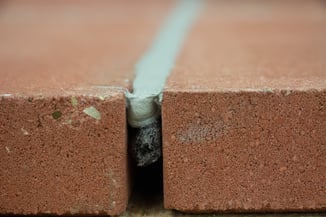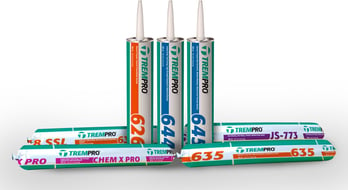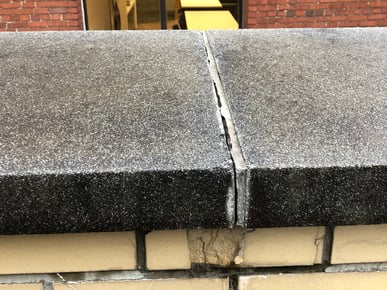In the construction industry, there are a lot of jargon, slang, and acronyms for seemingly similar building materials which can make it confusing when trying to select the best product for your specific application. This blog post will highlight the key differences between sealants, caulks, adhesives, and glues and offer guidance on how to find the best-suited one for your project.
Sealants vs caulk
The terms ‘sealants’, ‘caulk’, and ‘caulking’ are used interchangeably for the materials that block the passage of air and moisture. Historically, however, there has been a technical difference between them. Caulks are usually solvent- or water-based with minimal movement, +/- 10%, and are prone to shrinkage upon cure. Sealants tend to have more movement, typically ranging from +/- 25% to 100/-50%, minimal shrinkage upon cure, and enhanced weatherability capabilities. In present day conversations, those names are referencing the same materials. Note the exception, however, with expandable spray foams and pre-compressed foam tapes that are considered sealants/tapes but NOT caulk as they do not have the thicker liquid viscosity associated with traditional caulking.
Adhesives vs glue
Adhesive and glue are synonymous for products that adhere two or more substrates together. While the term ‘glue’ has a more consumer level connotation, such as for crafts, school projects, or minor household repairs, in the construction industry, these materials are more frequently referred to as ‘adhesives’.
Applications between sealants and adhesives
Construction sealants and adhesives are often packaged similarly, either in sausages or cartridges, and can work on the same types of substrates such as wood, glass, metal, etc. There are critical differences that must be considered when selecting between the two. Sealants should be used in applications to fill a gap that may be exposed to the elements and experience minor to moderate movement. There are multiple chemistry options for sealants, such as urethane or silicone technologies, which dictate their movement capabilities, cure time, compatible substrates, and other performance characteristics. Generally speaking, however, commercial-grade sealants are manufactured to be flexible and withstand natural building movement and the expansion and contraction of porous surfaces like wood. Depending on the specific product, sealants tend to skin over in a few hours, but may not fully cure for up to 10-14 days.
Sealants should be used in applications to fill a gap that may be exposed to the elements and experience minor to moderate movement. There are multiple chemistry options for sealants, such as urethane or silicone technologies, which dictate their movement capabilities, cure time, compatible substrates, and other performance characteristics. Generally speaking, however, commercial-grade sealants are manufactured to be flexible and withstand natural building movement and the expansion and contraction of porous surfaces like wood. Depending on the specific product, sealants tend to skin over in a few hours, but may not fully cure for up to 10-14 days.
Adhesives, on the other hand, are designed for use in confined spaces that are not exposed. For example, an adhesive may be used to adhere two products together and a sealant bead is used around the perimeter to prevent any moisture infiltration. Adhesives generally “stick” or cure faster than sealants, but some products can be adhered, separated, and then re-adhered to reposition any of the components. “Green strength” or “quick hold” is another important characteristic to consider, in which the product very quickly “grabs” onto the materials so you don’t need to wait for full cure for the necessary adherence.
A product described as an adhesive sealant can be used as both a sealant and an adhesive, but that does not mean it can seal or adhere to any or every substrate. When selecting a sealant or adhesive for your project, it is crucial to understand the adhesion and compatibility of the technologies and surrounding building materials, so be sure to consult the products’ manufacturers prior to application. Similarly, the prices of sealants and adhesives vary greatly depending on the stringency of the conditions they need to perform under.
How long is my sealant or adhesive going to last?
One of the most common questions we receive is, ‘how long is this product going to last?’ The answer is not always clear cut as building materials don’t operate in isolation, making performance and longevity heavily dependent on the following factors:
- Product selection

- Substrate preparation
- Installation procedures
- Weather and UV exposure
- Movement
Product selection- Choose a sealant or adhesive that explicitly states it can work with your particular project, including the substrates, anticipated movement, and weathering. Product data sheets and literature will clearly call out its features.
Substrate preparation- A sealant or adhesive is only as strong as the material it is sticking to. The substrate should be structurally sound, clear of any debris, clean, and dry before applying any products onto it. Proper substrate preparation will avoid any bond breakers that would inhibit the long-term adhesion of the products.
Installation procedures- Always follow the manufacturer’s installation instructions which include required climate conditions, tools, and sequencing of application. Abiding by these procedures helps the product perform for its prescribed life span and qualify for any manufacturer warranties. Weather and UV exposure- Sealant and adhesive chemistries react differently when exposed to moisture, extreme temperatures, dirt, and extended UV. Discoloration, staining, cracking and delamination of the products can occur so consider the time of day and upcoming weather conditions before applying. Ongoing maintenance will also protect your building from subsequent aesthetic issues, damage, and leaks.
Weather and UV exposure- Sealant and adhesive chemistries react differently when exposed to moisture, extreme temperatures, dirt, and extended UV. Discoloration, staining, cracking and delamination of the products can occur so consider the time of day and upcoming weather conditions before applying. Ongoing maintenance will also protect your building from subsequent aesthetic issues, damage, and leaks.
Movement- While building movement is inevitable, certain joints and locations are prone to varying degrees of vertical, horizontal, and shear movement. Compare the product’s movement capabilities with the anticipated movement of its location to ensure the two are compatible.
What’s Next
Now that you understand the differences between sealants and adhesives, you should be better equipped to find the right solution for your project. Product manufacturers’ installation instructions and warranties are a helpful guide in estimating how long the product should last under normal conditions and proper application. Consider conducting upfront or onsite testing, such as the field adhesion test, to assist with product selection.







